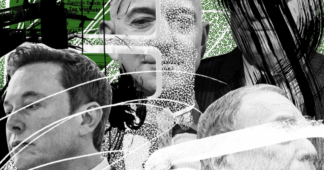Roth IRAs were intended to help average working Americans save, but IRS records show Thiel and other ultrawealthy investors have used them to amass vast untaxed fortunes.
Billionaire Peter Thiel, a founder of PayPal, has publicly condemned “confiscatory taxes.” He’s been a major funder of one of the most prominent anti-tax political action committees in the country. And he’s bankrolled a group that promotes building floating nations that would impose no compulsory income taxes.
But Thiel doesn’t need a man-made island to avoid paying taxes. He has something just as effective: a Roth individual retirement account.
Over the last 20 years, Thiel has quietly turned his Roth IRA — a humdrum retirement vehicle intended to spur Americans to save for their golden years — into a gargantuan tax-exempt piggy bank, confidential Internal Revenue Service data shows. Using stock deals unavailable to most people, Thiel has taken a retirement account worth less than $2,000 in 1999 and spun it into a $5 billion windfall.
To put that into perspective, here’s how much the average Roth was worth at the end of 2018: $39,108.
And here’s how much $5 billion is: If every one of the 2.3 million people in Houston, Texas, were to deposit $2,000 into a bank today, those accounts still wouldn’t equal what Thiel has in his Roth IRA.
What’s more, as long as Thiel waits to withdraw his money until April 2027, when he is six months shy of his 60th birthday, he will never have to pay a penny of tax on those billions.
ProPublica has obtained a trove of IRS tax return data on thousands of the country’s wealthiest people, covering more than 15 years. This data provides, for the first time, an inside look at the financial lives of the richest Americans, those whose stratospheric fortunes put them among history’s wealthiest individuals.
What this secret information reveals is that while most Americans are dutifully paying taxes — chipping in their part to fund the military, highways and safety-net programs — the country’s richest citizens are finding ways to sidestep the tax system.
One of the most surprising of these techniques involves the Roth IRA, which limits most people to contributing just $6,000 each year.
The late Sen. William Roth Jr., a Delaware Republican, pushed through a law establishing the Roth IRA in 1997 to allow “hard-working, middle-class Americans” to stow money away, tax-free, for retirement. The Clinton administration didn’t want to give a fat tax break to wealthy people who were likely to save anyway, so it blocked Americans making more than $110,000 ($160,000 for a couple) per year from using them and capped annual contributions back then at $2,000.
Yet, from the start, a small number of entrepreneurs, like Thiel, made an end run around the rules: Open a Roth with $2,000 or less. Get a sweetheart deal to buy a stake in a startup that has a good chance of one day exploding in value. Pay just fractions of a penny per share, a price low enough to buy huge numbers of shares. Watch as all the gains on that stock — no matter how giant — are shielded from taxes forever, as long as the IRA remains untouched until age 59 and a half. Then use the proceeds, still inside the Roth, to make other investments.
About a decade after the creation of the Roth, Congress made it even easier to turn the accounts into mammoth tax shelters. It allowed everyone — including the very richest Americans — to take money they’d stowed in less favorable traditional retirement accounts and, after paying a one-time tax, shift them to a Roth where their money could grow unchecked by Uncle Sam — a Bermuda-style tax haven right here in the U.S.
From $2,000 to $5 Billion: How the .001% Use Retirement Accounts as Tax-Free Piggy Banks
To identify those who have amassed fortunes in retirement accounts, ProPublica scoured the tax return data of the ultrawealthy for IRA accounts valued at more than $20 million. Reporters also examined Securities and Exchange Commission filings, court documents and other records, including a memo detailing Thiel’s wealth that was included in his 2005 application for residency in New Zealand.
Among this rarefied group, ProPublica found, the term “individual retirement account” has become a misnomer. Rather than a way to build a nest egg for old age, the accounts have morphed into supercharged investment vehicles subsidized by American taxpayers. Ted Weschler, a deputy of Warren Buffett at Berkshire Hathaway, had $264.4 million in his Roth account at the end of 2018. Hedge fund manager Randall Smith, whose Alden Global Capital has gutted newspapers around the country, had $252.6 million in his.
Buffett, one of the richest men in the world and a vocal supporter of higher taxes on the rich, also is making use of a Roth. At the end of 2018, Buffett had $20.2 million in it. Former Renaissance Technologies hedge fund manager Robert Mercer had $31.5 million in his Roth, the records show.
Buffett didn’t respond to questions sent by email. Mercer couldn’t be reached for comment, and his accountants and attorneys didn’t respond to requests to accept questions on his behalf. Smith also couldn’t be reached for comment, and an employee at his hedge fund repeatedly hung up when ProPublica reporters identified themselves. Other representatives for Smith and his hedge fund didn’t respond.
In a written statement, Weschler said his retirement account relied on publicly traded investments and strategies available to all taxpayers. Nevertheless, he said he supports reforming the system.
“Although I have been an enormous beneficiary of the IRA mechanism, I personally do not feel the tax shield afforded me by my IRA is necessarily good tax policy,” he wrote. “To this end, I am openly supportive of modifying the benefit afforded to retirement accounts once they exceed a certain threshold.”
A spokesman for Thiel accepted detailed questions on Thiel’s behalf, then never responded to phone calls or emails. Messages left at Thiel’s venture capital fund were not returned.
While the scope and scale of such accounts has never been publicly documented, Congress has long been aware of their existence — and the ballooning tax breaks they were garnering for the ultrawealthy. The Government Accountability Office, the investigative arm of Congress, for years has warned that the wealthiest Americans were accumulating massive retirement accounts in ways federal lawmakers never intended.
At the same time, Congress has slashed the IRS’ budget so severely that the agency’s ability to ferret out abuses has been stymied. Money was so tight that at one point in 2015 the agency couldn’t afford to enter critical data about IRAs from paper tax filings into its computer system.
Over the years, a few politicians have tried, and failed, to crack down on the tax breaks the ultrarich receive from their giant IRAs.
In 2016, Sen. Ron Wyden, an Oregon Democrat, floated a detailed reform plan and said, “It’s time to face the fact that our tax code needs a dose of fairness when it comes to retirement savings, and that starts with cracking down on massive Roth IRA accounts built on assets from sweetheart, inside deals.”
“Tax incentives for retirement savings,” he added at the time, “are designed to help people build a nest egg, not a golden egg.”
But Wyden soon abandoned his proposal; there was no chance the Republican-controlled Senate would pass it.
Meanwhile, Thiel’s Roth grew.
And grew.
At the end of 2019, it hit the $5 billion mark, jumping more than $3 billion in just three years’ time — all of it tax-free.
Thiel, a fan of J.R.R. Tolkien, by then had brought his Roth under the auspices of a family trust company called Rivendell Trust. In “The Lord of the Rings,” Rivendell is a secret valley populated by elves, a misty sanctuary against forces of darkness. Thiel’s earthly version resides in a suburban Las Vegas office complex, across from a Cheesecake Factory, and is staffed by a small group of corporate lawyers.
And thanks to the Roth, Thiel’s fortune is far more vast than even experts in tallying the wealth of the rich believed. In 2019, Forbes put Thiel’s total net worth at just $2.3 billion. That was less than half of what his Roth alone was worth.
Continue reading at www.propublica.org











